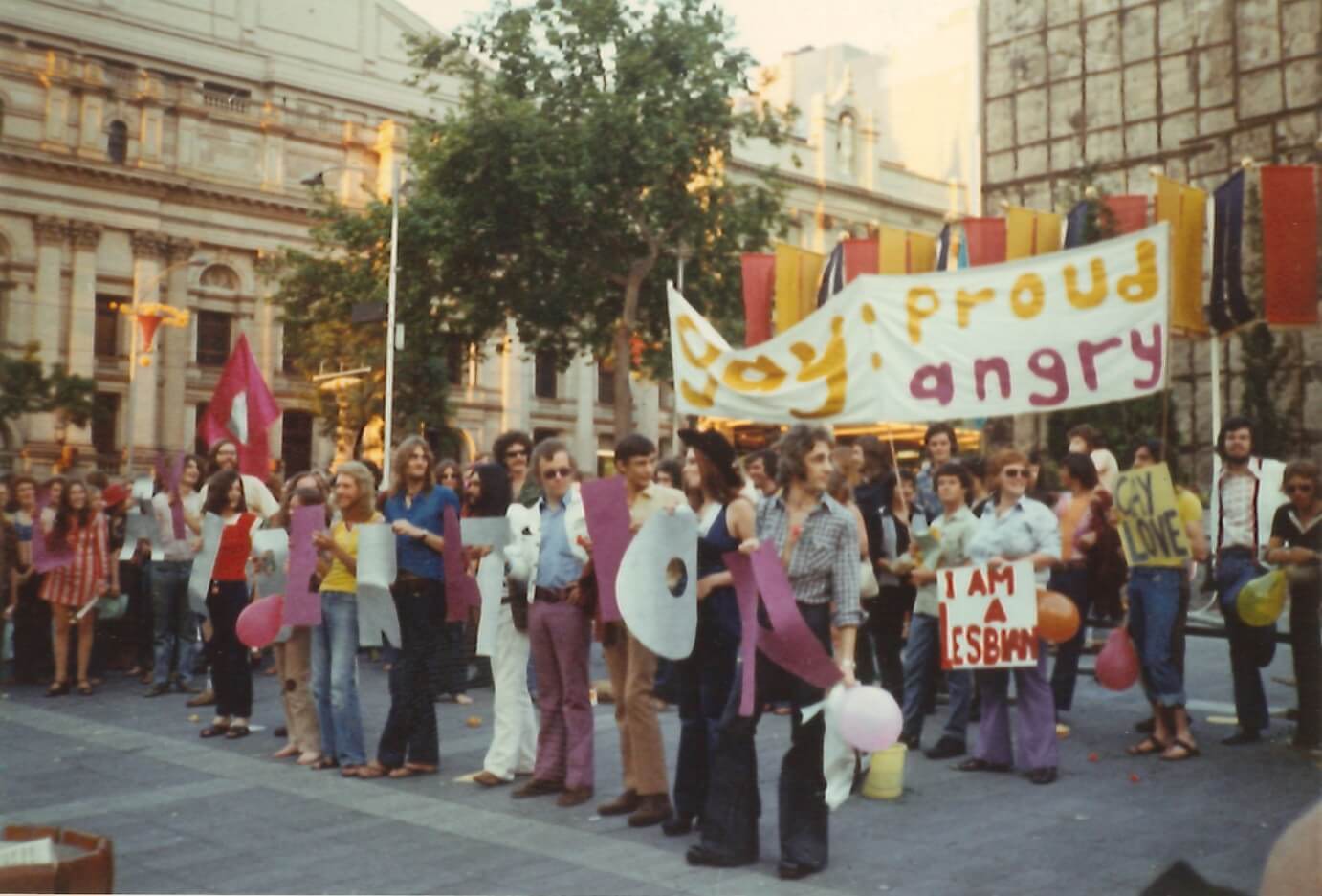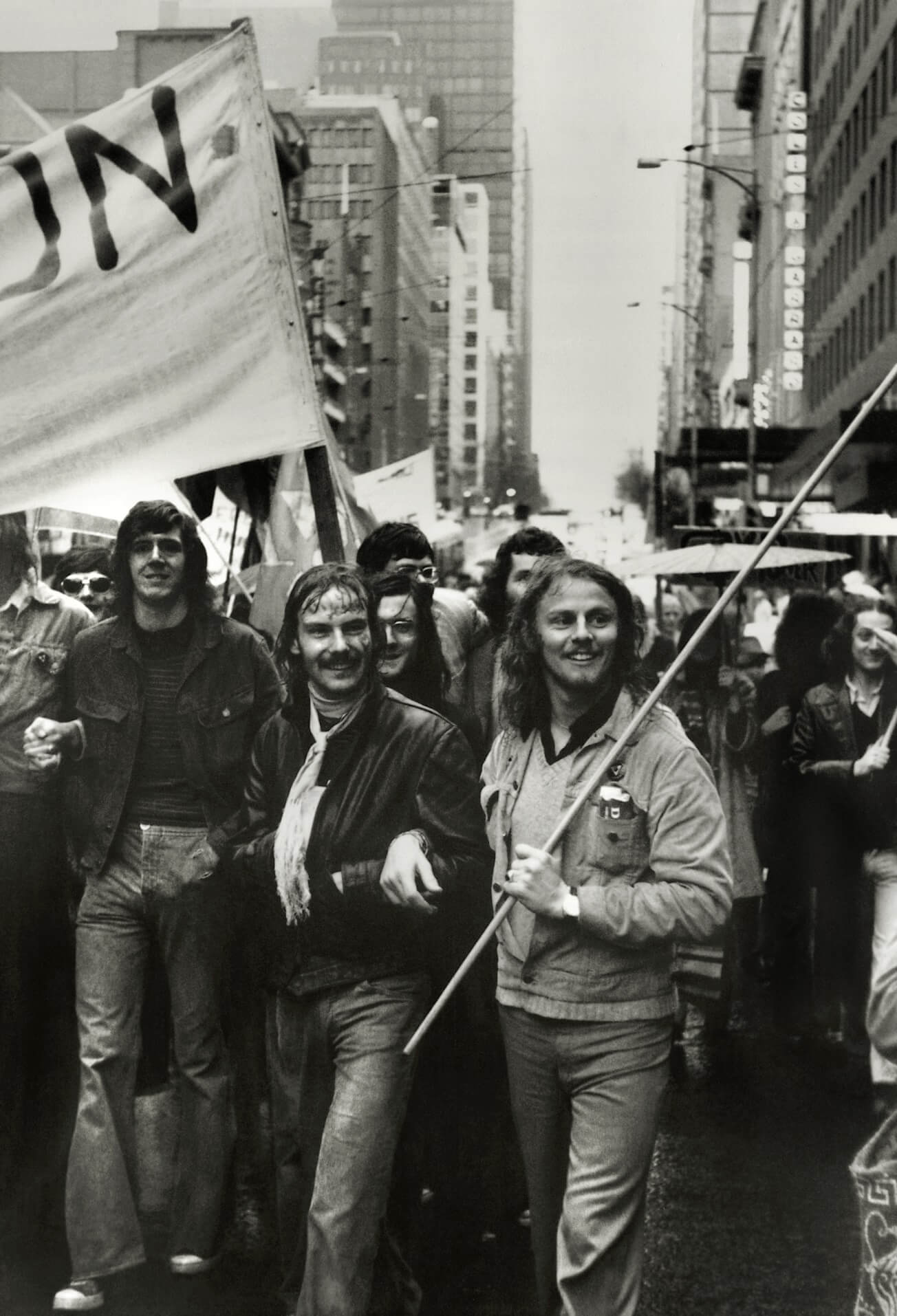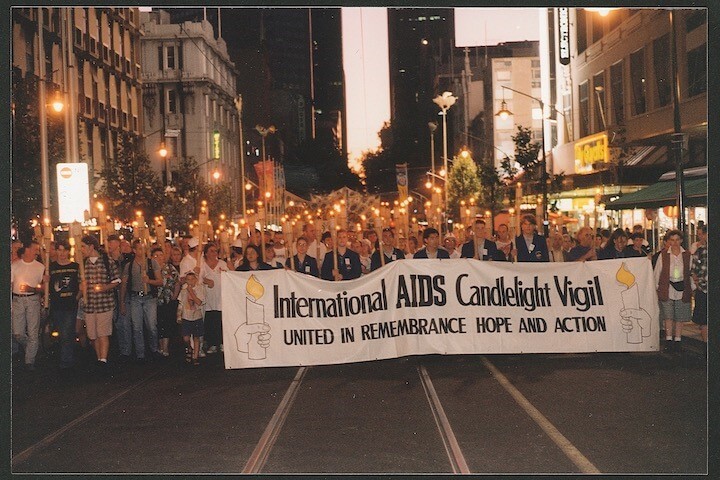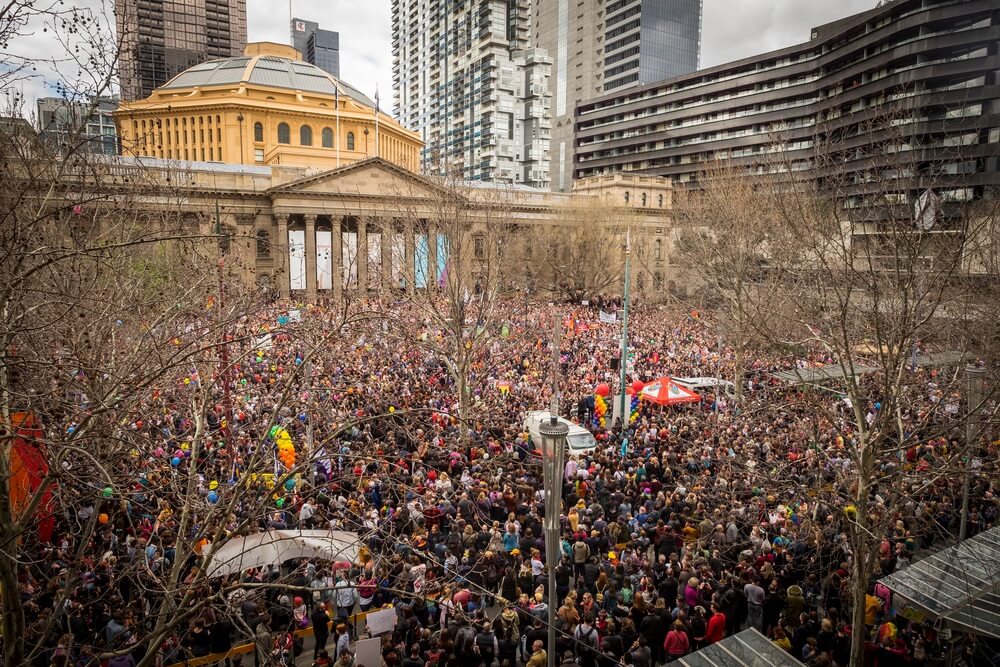Members of Victoria’s LGBTQIA+ community faced active discrimination until the 1980s. Male homosexuality was criminalised and many were shamed and imprisoned. For most of this time the gay community was a clandestine one.
Agitation for change - the 1970s
Gay men and lesbians came ‘out of the shadows’, declaring their sexuality and lobbying for reform. Terms such as ‘gay’, ‘lesbian’ and ‘coming out’ became a badge of pride, not a stigma.
Navigation
Aboriginal Rights
Workers' Rights
Women's Rights
-'We're here. We're Queer. Get used to it!
Protest for Peace
Environmental Activism
The Right to Protest in a Democracy
Demonstration organised by Melbourne’s Gay Liberation, City Square, December 1972: ‘A unique treat for Melbourne’s busy shoppers’.
Reproduced courtesy Australian Queer Archives, photograph by Peter McEwan
This was one of the earliest demonstrations organised by the Melbourne branch of Gay Liberation. The flyer promoting the event read:
Gay Lib is a group of homosexuals who are open about their homosexuality, under the belief that it is better for our own wellbeing, and ultimately points out the way in which we carry a heavy load in society, and means with which to overcome this.
Showing ourselves in public is a step in creating confidence from our homosexuality.
If you are camp, your presence as a participant will give us added support; your presence as an onlooker will give you a spectacle that is guaranteed to relieve the dreariness of Friday night shopping.
The Melbourne branch of Gay Liberation was formed in 1972. They worked within the gay and lesbian communities seeking equal opportunity and an end to discrimination. In 1973 the Australian Medical Association ceased officially to regard homosexuality as an illness. In 1975 South Australia decriminalised sexual conduct between men: Victoria followed suit in 1981.
A street march, part of Gay Pride Week, Melbourne, 1973
Reproduced courtesy Australian Queer Archives, photograph by Frank Prain
Gay Pride Week was directed at the ‘prejudiced, the fearful and the conditioned’. It allowed the gay community to come ‘out of the shadows’ - to stand proud, and stand up for their rights.
Protesters kiss outside the Hotel Australia in Collins Street, Melbourne 1979
Reproduced courtesy The Age newspaper
‘Coming out’ became a powerful form of protest. In 1979, activists staged a kissing protest on the spot where two men had been arrested and later convicted of ‘indecency’ for the same act.
AIDS
The first known case of AIDS in Australia was diagnosed in 1982. It was immediately associated with unsafe sex and gay men were targeted. The LGBT community responded by forming AIDS Councils across Australia, offering support and education. The first Candlelight Vigil was held in Melbourne in 1985.
International AIDS Candlelight Vigil, Swanston Street, Melbourne, 1996
Reproduced courtesy Australian Lesbian and Gay Archives
The Vigil was started by two Melburnians, Phil Carswell and Tom Carter. By 1994 vigils attracted 60,000 nationally. People with HIV, their families, friends, carers, activists and politicians – ‘those who understood the human cost of the disease’ – came together to remember those who had died. It was ‘a way of remembering those lost to the epidemic… the names of those who had died were read out. All around, one could hear the sounds of people weeping. It was a distressing time.’
The vigils were also an opportunity to educate passers-by about AIDS and the impact it had on the lives of thousands of people.
Towards equality
Progress towards equality has been slow but steady. In 1992 the Keating Labor Government removed the ban on same-sex attracted men and women in the military. In 2009 the Rudd Labor government removed discrimination against same-sex couples from 85 federal laws. Two years later the Gillard Labor government passed passport legislation allowing for an 'x' gender option and the Sex Discrimination Act was amended making discrimination against LGBTQIA+ people unlawful. In 2016, Labor Premier Daniel Andrews formally apologised for the state’s anti-gay laws.
Most recently, the Turnbull Liberal Government amended the Federal Marriage Act, allowing same-sex couples to marry.
More than 20,000 Melburnians rally for same-sex marriage, 2017
Reproduced courtesy The Age newspaper
In November 2017 the Australian Government held a voluntary postal survey asking eligible voters to answer ‘yes’ or ‘no’ to the question: ‘Should the law be changed to allow same-sex couples to marry?’
Close to 13 million people (nearly 80 per cent of eligible Australians) responded. On 15 November the results were announced: 61.6 per cent of participants voted ‘yes’. Three weeks later, the Australian Parliament amended the Marriage Act, redefining marriage as ‘a union of two people’.
Still some way to go
Today there is general acceptance of same-sex relationships, but the struggle for equality continues. Perhaps the most contentious area is treatment of young LGBTQIA+ and gender-questioning youth.
Author: Ann Wilcox
Further reading:
Graham Willett, Living out loud: A history of gay and lesbian activism in Australia, Sydney: Allen & Unwin, 2000
Abigail C. Saguy, 'The history of ‘coming out,’ from secret gay code to popular political protest' The Conversation, February 11 2020
Liam Elphick, 'Marriage equality was momentous, but there is still much to do to progress LGBTI+ rights in Australia' The Conversation, March 6 2019
A definitive timeline of LGBT+ rights in Australia, SBS Australia (archive web copy)
Suzanne Fairbanks and Graham Willett, 'Gay liberation'. Archived from 'Protest! Archives from the University of Melbourne'
Jennifer Power, Movement, Knowledge, Emotion: Gay activism and HIV/AIDS in Australia, 'Rites of Belonging: The AIDS Memorial Quilt'.
Hamilton, Clive, What Do We Want? The Story of Protest in Australia, National Library of Australia Publishing: Canberra, A.C.T., 2016
Willett, Graham, Living out loud: a history of gay and lesbian activism in Australia, Allen & Unwin: St Leonards, N.S.W., 2000





